HR Risk Management: 9 Types Of Risks & Ways To Reduce

HR risk management is more important than ever. Today, 42% of employees say their needs at work aren’t being met, double the number from recent years. Add fast-changing tech and growing mental health demands, and the pressure on businesses keeps rising. In this guide, MOR Software’ll break down what risk management in HR means, why it matters, common risk areas, and how to build a plan that protects your people and your business.
What is HR Risk Management?
HR risk management means spotting and handling the people-related risks that can hurt your business. This includes everything from hiring and retention to employee behavior, compliance, and workplace safety.
You can’t erase every risk. But with the right systems, you can catch issues early and respond before they get worse. Most risk management in HR comes down to planning ahead. That means using data, trends, and experience to decide what might go wrong, what’s worth worrying about, and how to deal with it.
This goes well beyond just following labor laws. You’re also managing risks tied to ethics, tech access, personal info, morale, and team dynamics. That’s why having a solid HR risk assessment process matters.
To manage risk, most HR teams lean on four basic strategies:
- Avoid the risk entirely by not engaging in risky actions.
- Accept the risk when avoiding it costs more than managing it.
- Reduce the risk through safeguards and smart processes.
- Share the risk with partners or external services.
What works best depends on your business goals, team structure, and existing tools. That’s where HR and risk management come together to shape practical decisions.
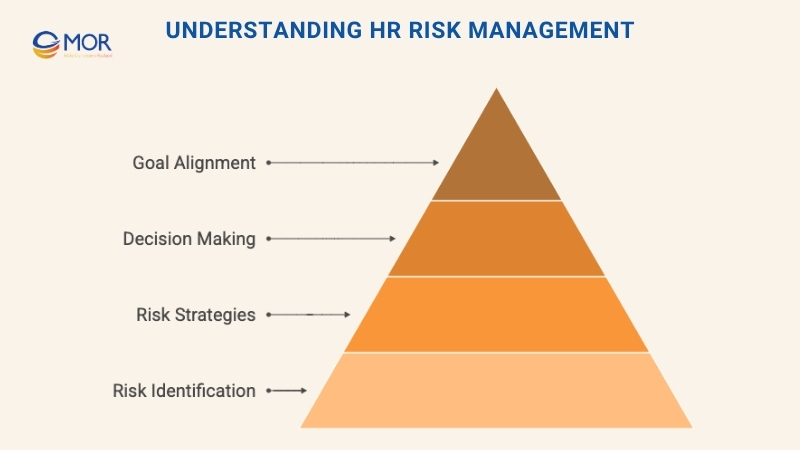
What is HR Risk Management?
Why Is HR Risk Management Important?
A strong HR risk management plan gives your team the structure to prevent issues, respond quickly, and support both employees and the business. It’s not just about reacting to problems. It’s about creating a safer, more consistent, and more productive workplace from the start.
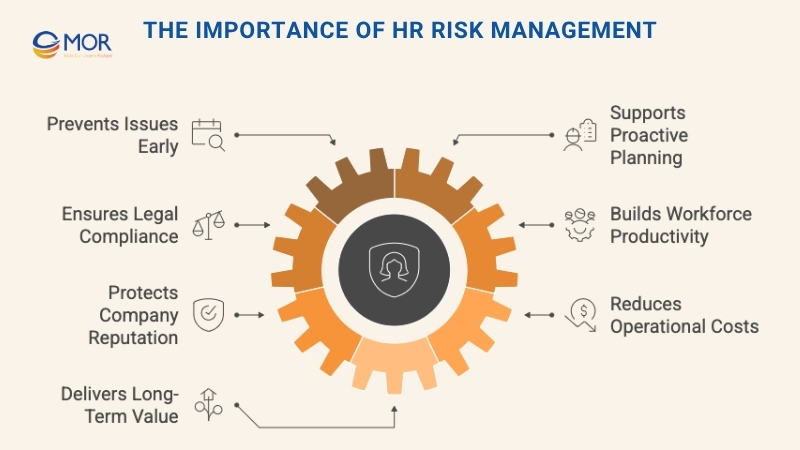
Why Is HR Risk Management Important?
Enables a Proactive Approach to HR Issues
When risks are identified early, you can act before they grow into bigger problems. A clear plan helps your team understand what steps to take and when, which reduces decision fatigue and keeps everyone aligned. It also helps your HR team save time by avoiding repetitive problem-solving or last-minute crisis management.
Modern work environments, like hybrid setups, shifting roles, and varied employee classifications, create complexity. Combined with fast-paced technology changes, it’s harder than ever to manage people without a forward-thinking plan. A proactive approach gives you room to adapt as the business grows and the workforce evolves.
Ensures Compliance
Non-compliance is one of the most expensive HR risks a company can face. Labor laws, safety standards, and employment regulations are constantly changing. Without proper checks, even a small oversight can lead to fines, lawsuits, and damaged employee trust.
By embedding compliance into daily workflows, HR risk management reduces exposure and helps your business stay aligned with national, regional, and local laws. It also supports stronger internal documentation, which becomes critical if disputes ever reach legal channels.
Builds a Productive Workforce
Today’s workforce isn’t limited to full-time employees. Many companies hire contractors, leased staff, and gig workers. This expansion brings more flexibility, but also more risk. Without clear policies and fair treatment across the board, engagement suffers, and performance drops.
With the right plan, HR can manage this complexity. A good HR and risk management strategy ensures people are in roles where they thrive, supported with tools and policies that align with the company’s goals. When done well, this leads to better retention, higher motivation, and teams that actually perform.
Preserves and Improves the Organization’s Reputation
One HR misstep can go public in minutes. Social media and employee review platforms have made reputational risk a serious concern. Discrimination claims, toxic workplace allegations, or mishandled investigations can damage how customers, future hires, and the public see your company.
A proactive HR risk management plan helps you detect warning signs early, through feedback, behavior trends, or audits, and respond quickly. This builds internal trust and protects external perception. When employees see that issues are addressed fairly and transparently, it also improves workplace morale.
Reduces Costs
Legal action, penalties, and high turnover don’t just affect operations, they drain resources. Settling a labor dispute, investigating harassment claims, or replacing key team members comes with steep costs.
A well-executed plan helps reduce these risks early. By focusing on prevention, like strong compliance practices, healthy workloads, and fair pay, your company can avoid costly problems. Plus, with better employee engagement and retention, you cut the recurring expense of recruiting, onboarding, and training new hires.
Long term, this kind of planning pays off. Whether it’s tracking behavior patterns, reviewing policies, or using tools like HR risk management solutions, the cost of prevention is always lower than the cost of recovery.
Common Types of HR Risk Management Challenges
Managing people always comes with risk. From hiring to retention, behavior to benefits, HR teams handle situations that directly affect business health. Let’s look at the biggest areas where HR risk management makes a difference.
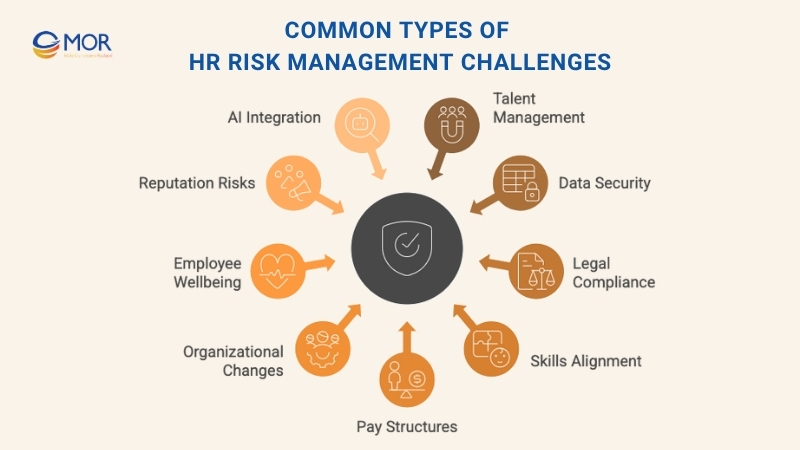
Common Types of HR Risk Management Challenges
Talent and Workforce Management Risks
Keeping the right people, and keeping them motivated, isn’t easy. High turnover, burnout, poor communication, and workplace tension all hurt performance. Hybrid and remote setups add more layers. Without regular face time, it’s easier for teams to feel disconnected or misaligned.
Some companies lean too hard into rigid policies. Others offer too much flexibility without guardrails. Either way, the result is often confusion or disengagement.
These workforce issues don’t just impact output. They affect retention, morale, and the bottom line. That’s why risk management HR teams need to plan ahead for shifting work styles, team structures, and employee needs.
This is also where using smart tools like conduct risk software can help flag early warning signs before problems spread.
Security and Privacy of Employee Information
Protecting employee data is non-negotiable. Your HR team handles everything from personal IDs and bank details to health records. If that information isn’t properly stored or shared, you’re one breach away from a legal nightmare.
Strong policies, clear access rules, and secure systems are the foundation. Anyone handling sensitive info, whether it’s employee files or customer data, needs clear instructions and ongoing training.
In today’s digital workplace, human resources risk management must include cybersecurity and data protection. One misstep can mean lawsuits, lost trust, and a damaged reputation. This is where using employee compliance software to track who accesses what, and when, can make a big difference.
Legal Compliance and Ethical Standards
Laws change. Fast. Your HR team has to stay sharp, tracking labor rules, safety regulations, data privacy updates, and how roles are classified. Missing a requirement can lead to costly penalties or even lawsuits.
But HR risk management isn’t just about legal checklists. It’s also about setting a strong ethical tone. That means fair hiring, unbiased promotion, respectful terminations, and making sure every team member has equal access to opportunity.
The overlap between ethics and law is huge. When handled well, it builds trust, cuts down on disputes, and supports a healthier work culture. This is where having a clear hr risk assessment process helps you catch issues early and stay consistent.
Staff Learning, Training, and Skills Alignment
Your team’s skills should match your business goals. When they don’t, performance suffers. That’s why training isn’t just a perk, it’s a core part of HR risk management.
According to Mercer, reskilling and upskilling are now top concerns for HR leaders. And no surprise, less than half of employees believe their manager understands their actual strengths and gaps.
If you’re not investing in development, you're risking stalled growth and employee turnover. Workers want to grow. If they don’t see that chance, they’ll find it elsewhere.
That’s why HR risk management solutions need to include regular skills audits, personalized training plans, and learning tools that keep your workforce sharp and engaged.
Pay Structures and Employee Benefits
Getting compensation right is more than a numbers game. It’s about fairness, clarity, and meeting evolving expectations. HR teams have to offer competitive packages that attract talent, without breaking the budget.
Recent data shows 46% of employees would give up a 10% raise for better wellbeing benefits. Another 41% say they’d trade the same raise for stronger retirement contributions. That’s a clear signal: benefits matter just as much as salary.
Still, many employees don’t feel the system is fair. Only 38% say their employer is transparent about pay. Just a third believe promotions are handled fairly.
That’s a big risk. Lack of transparency leads to frustration, mistrust, and higher turnover.
HR risk management means building pay systems that reflect market standards, support equity, and make sense to employees. Tools like risk management in HR platforms can help monitor trends, flag inconsistencies, and drive smarter decisions.
HR Challenges During Mergers, Acquisitions, or Restructuring
Mergers and acquisitions shake up everything, especially your workforce. And if HR risk management isn’t involved early, the fallout can be costly.
One major problem? Leadership turnover. Studies show up to 75% of key managers leave within two to three years after an acquisition. When that happens, business continuity takes a hit.
That’s why HR must play a central role in planning transitions, retaining talent, and aligning new teams. This includes clear communication, updated roles, and consistent support through the changes.
With the help of modern HR and risk management tools, your team can track sentiment, flag early warning signs, and build smoother transitions that protect long-term performance.
Employee Health, Safety, and Wellbeing
Workplace safety isn’t just about hard hats and fire drills anymore. HR risk management now covers everything from physical hazards to mental health and emotional wellbeing.
Stress, burnout, and anxiety are just as harmful as unsafe equipment, and they’re becoming more common. If ignored, these issues lead to absenteeism, low morale, and high turnover.
It’s up to HR to set clear safety policies, support mental health, and create a culture where people feel safe speaking up. With the right policies in place, and the support of tools like human resources risk management software, you can prevent small problems from turning into major setbacks.
Risks to Company Reputation from Employee Actions
One bad incident can go viral, and damage your brand overnight. Public disputes, bias claims, or shady behavior don’t just stay internal. With social media, reputational risk spreads fast.
That’s why HR risk management must include protecting your company’s image. When employee behavior crosses the line, it affects hiring, retention, and customer trust.
HR sets the tone for workplace culture. Clear conduct policies, strong communication, and fast, fair responses are key. How your team handles a sensitive situation often matters more than the issue itself.
This is where risk management HR processes help shape a workplace that’s not just productive, but respected, inside and out.
New Risks Tied to AI Tools and Automation in HR
AI is changing how HR works, from hiring to reviews to workforce planning. But with that power comes new responsibility. As part of HR risk management, teams need to keep a close eye on how AI is used, what data it relies on, and how decisions are made.
AI tools can be fast and efficient. But if the data they’re trained on has bias, that bias gets baked into your hiring or review process. Worse, it’s often hard to trace or explain those decisions later.
Employees also have concerns. Many don’t fully understand how these tools work or how their data is being used. That lack of clarity breeds mistrust.
To manage these risks, HR must work with legal, tech, and leadership teams to set clear rules. Every AI system needs oversight, documentation, and regular reviews.
With smart planning and the right risk management in HR processes, you can adopt AI without creating new headaches, or legal trouble.
How To Create an HR Risk Management Plan
A strong HR risk management strategy has to be intentional. It should fit your company’s structure, culture, and industry. No copy-paste templates here. What works for one business might miss key risks in another.
To build something that works, you can follow these six steps.
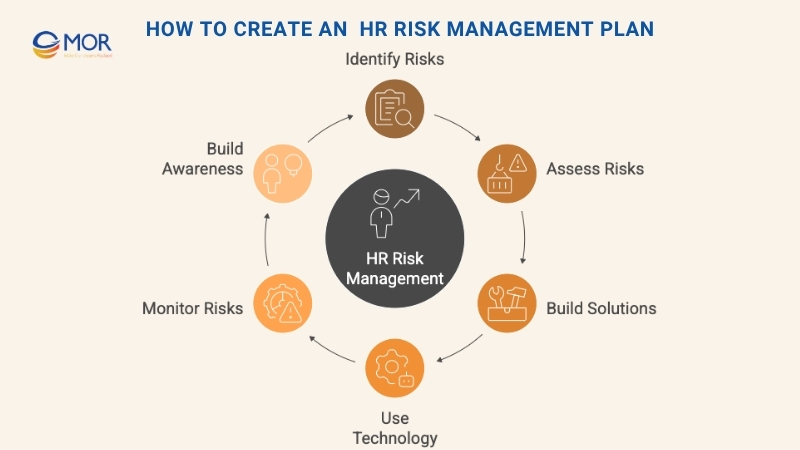
How To Create an HR Risk Management Plan
Step 1 – Identify HR Risks in Your Organization
Start by running a complete audit of your current HR practices. This includes policies, workflows, systems, and real-life situations you've had to handle. Where have problems come up in the past? Where do gaps still exist?
Use internal data to guide you. Look at turnover rates, engagement levels, manager feedback, and employee complaints. HR analytics tools can flag early warning signs. If many employees leave after six months, something’s wrong in your onboarding. If engagement scores are dipping, you may be underinvesting in development or overloading teams.
Think big picture, too. Every company faces general HR risks: compliance, fair pay, upskilling, safe working conditions, and behavior issues. But your industry might bring unique risks you can’t ignore.
If you run a home care service, your people work one-on-one with vulnerable clients. That means risks like working alone, unclear boundaries, or expired licenses. In this case, your HR and risk management approach should include certifications tracking and behavior guidelines for remote workers.
The more precisely you identify risks, both shared and industry-specific, the stronger your plan will be.
Step 2 – Assess the Risks and Prioritize Your Actions
Once you’ve mapped out the risks, don’t treat them all the same. Some will require urgent action. Others can wait. That’s why the next step in your HR risk management plan is to sort and rank each risk by severity and likelihood.
Start by asking these four key questions:
- How likely is this to happen?
- Can we fully prevent it?
- If it happens, how serious is the fallout?
- Can we reduce the damage if it occurs?
This gives you a clearer picture of what’s urgent, what’s manageable, and what needs a long-term fix. Use proven HR risk assessment tools or simple risk matrices to group issues into high, medium, and low categories. Break them down by HR area, legal compliance, hiring, tech systems, benefits, or culture, and assess each in context.
Focus first on risks that carry legal exposure, such as non-compliance with labor laws or unfair pay practices. These often cost the most, both financially and reputationally. If your compliance risks are under control, shift focus to performance-related issues like skill gaps or retention.
Not every risk will threaten the company today, but all of them tie into long-term goals. The goal of this phase is to turn a long, scattered list into a set of clear priorities you can act on, one that supports smarter, more focused HR risk management solutions.
Step 3 – Build and Apply Your Risk Solutions
Now that you’ve ranked your risks, it’s time to take action. A good HR risk management plan doesn't just list risks, it shows how to reduce them. This step is where theory turns into practice.
Start by choosing the right risk response method for each issue:
- Avoid it altogether.
- Accept it if the cost of removing it is too high.
- Reduce or prevent it through safeguards.
- Share it by outsourcing or involving third parties.
Then design your action steps. Make sure they’re specific, realistic, and tied to your earlier assessment. Below are two real-world examples of using loss prevention and reduction strategies to control risk.
Managing Employee Conduct Risks
An employee with poor behavior, performance issues, or toxic influence can hurt team morale, increase turnover, or spark legal trouble. These risks are manageable, with the right safeguards in place.
Key practices include:
- Vetting candidates thoroughly before hiring
- Running structured onboarding that covers job expectations, behavior policies, and compliance basics
- Giving every employee a detailed job description and confirming their understanding
- Distributing an updated employee handbook with signed acknowledgment
- Offering regular policy refreshers and training sessions
- Documenting manager check-ins, coaching efforts, and any disciplinary action
All of this builds a consistent and fair approach, reducing behavior-based risk across the board.
Addressing Compliance and Security Gaps
Failing to follow labor laws or mishandling data can lead to lawsuits, fines, and reputational loss. These risks aren’t always visible until it’s too late.
To lower exposure:
- Audit your HR workflows routinely
- Assign someone in HR to track law updates and high-risk legal trends
- Train employees to protect sensitive data and follow privacy standards
- Team up with legal counsel or compliance experts for policy reviews
These moves strengthen your HR risk management foundation and support better decision-making long term.
HR tip: Don’t wait for a crisis to build a plan. Create a response guide now, with backup teams, point people, and communication steps, so you can act fast when surprises hit.
This is also where the right tech matters. Tools like employee compliance software can flag gaps automatically, track certifications, and store signed policy documents, all in one place.
Step 4 – Use Technology to Reduce Risk
Technology is a key part of smart HR risk management. It takes the manual pressure off your team and helps catch problems before they escalate.
Automating repetitive tasks, like compliance tracking, certification renewals, or policy updates, reduces human error and improves consistency. When systems run checks automatically, your HR team doesn’t have to chase details or fix mistakes later.
Modern HR software can flag missing documents, track incident reports, and alert you when a license is about to expire. Some tools even monitor unusual system activity for better cybersecurity.
The right setup not only lowers risk, it also frees your team to focus on people, not paperwork. With less time spent on admin, HR can shift toward strategy, culture, and long-term planning.
This is where integrated tools like best HR compliance software really shine, keeping your data secure, processes tight, and team focused on what matters most.
Step 5 – Monitor Risks on an Ongoing Basis
HR risk management isn’t a one-time project, it’s a continuous process. Risks evolve. People leave. Laws change. What worked six months ago might fall short today.
That’s why you need a system to regularly review, update, and improve your plan. Build in checkpoints to track performance and catch new risks early.
Use benchmarks and HR KPIs, like turnover rates, policy violations, or response times, to measure your progress. Set goals and compare against past data to see what’s improving and where you’re slipping.
Collect feedback often. Surveys, one-on-one interviews, exit conversations, and even anonymous suggestion boxes can reveal real-time concerns. These tools keep your team connected and give employees a voice in the process.
To check how your HR risk management solutions are holding up, ask questions like:
- Are we reducing risks effectively?
- Do employees understand and follow our policies?
- Have any risks changed or gotten worse?
- Have new threats emerged?
- Is the plan being clearly communicated?
- Does our team need more training?
Keeping this loop active helps you stay ahead of problems, not just react to them. It also supports a stronger culture of accountability and makes your human resources risk management strategy more resilient long term.
Step 6 – Build Risk Awareness Across the HR Team
Your HR risk management plan is only as strong as the people behind it. That’s why growing risk awareness across your team is essential, not just for today, but for the long run.
Everyone on your HR team should feel confident spotting risks early, knowing how to respond, and taking action before issues escalate. These skills aren’t just nice to have, they’re part of the core toolkit for modern HR.
One way to build that capability? Partner with departments that already handle risk well, like legal, finance, or IT. Host a joint workshop or training session. Learn how they think about threats, track them, and respond under pressure.
Encourage your team to stay sharp by following legal updates, workplace trends, and changes in employee expectations. As HR and risk management continues to evolve, staying informed helps your team stay compliant and proactive.
Developing this mindset turns HR from a support function into a strategic partner, one that adds ongoing value and helps your company stay future-ready.
Best Practices for Effective HR Risk Management
Building a strong HR risk management plan is one thing. Keeping it relevant and effective over time is another. These best practices will help your team stay ahead of workforce risks and support long-term success.
- Make risk planning part of everyday HR strategy: Don’t wait for problems to show up. Bake risk thinking into your regular HR work, whether it’s updating policies, planning workforce shifts, or choosing new tools. When risk awareness becomes routine, you’re less likely to get blindsided.
- Keep detailed documentation: Clear records matter. Store all your policies, compliance logs, performance actions, and training materials in one place. This not only protects you legally but also creates transparency across teams. Documentation helps you act fast and fairly when issues come up.
- Practice scenario planning: Use “what-if” exercises to test your team’s readiness for disruptions, like sudden resignations, compliance issues, or public employee disputes. These dry runs reduce panic and confusion during real events, giving your team a calm playbook to follow.
- Bring in outside experts when needed: Legal and IT regulations shift constantly. Tapping into outside consultants or specialists helps you spot blind spots, tighten weak areas, and stay compliant. The right input can make your hr risk management solutions sharper and more future-proof.
- Secure leadership support across departments: When senior leaders back your risk efforts, it sets the tone for the whole company. Risk management becomes everyone’s responsibility, not just HR’s. That kind of culture helps surface issues early and keeps teams aligned.
- Revisit your strategy often: Risks shift fast. So should your plan. Make time for routine check-ins, quarterly or biannually, to review what’s working, what’s outdated, and what needs a new approach. As laws, tech, and employee needs evolve, your risk management in HR strategy should evolve too.
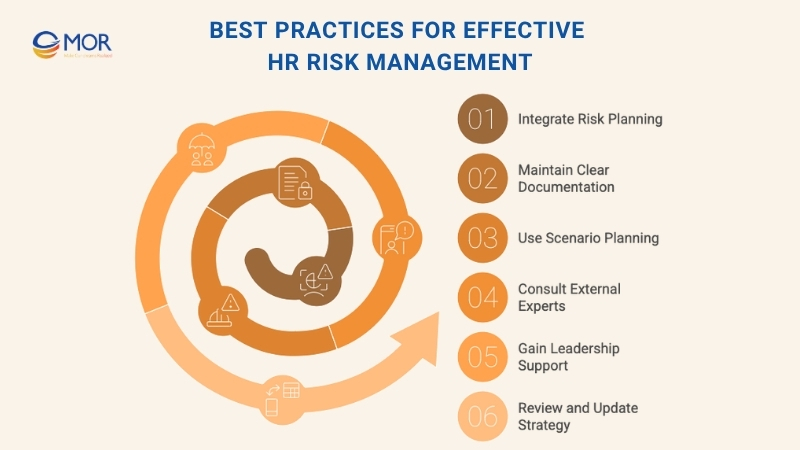
Best Practices for Effective HR Risk Management
Real-World Examples of HR Risk Management
Let’s take a look at how companies are applying HR risk management in real business scenarios.
Rapid-Growth Contractor: Building Policies to Manage Hiring Risks
A for-profit contractor was scaling fast, bringing on new hires at a rapid pace. But with that growth came hidden risks. The company had no structured hiring policies, few documented procedures, and lacked key insurance coverage, putting them at legal and financial risk.
Exude, a people-focused consulting firm, stepped in to run a full HR risk assessment. What they found was clear: hiring without safeguards was exposing the business on multiple fronts.
They helped the company implement a formal hiring process, added background checks, and created onboarding steps to improve retention. They also built out company-wide HR policies and set up proper insurance coverage to protect against employee disputes.
By addressing these gaps early, the business avoided costly issues and created a stronger, more secure foundation for continued growth. This is a textbook example of using proactive human resources risk management to turn growing pains into long-term success.
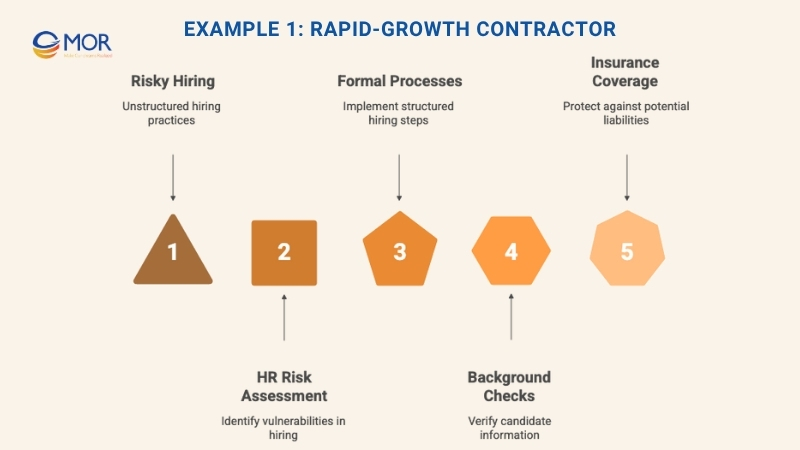
Rapid-Growth Contractor: Building Policies to Manage Hiring Risks
Fitness Provider: Turning Around HR Compliance During an Acquisition
A fitness services provider was preparing to acquire a struggling competitor, one already facing serious legal trouble tied to employee issues. The competitor had filed for bankruptcy and was missing key HR fundamentals.
No proper systems. Disorganized payroll. No accurate time tracking. Broken leave policies. Benefits that didn’t meet legal standards. And employees spread across different states with varying labor laws.
To avoid inheriting a legal mess, the company brought in The Pacific Crest Group (PCG), a firm specializing in HR and accounting support. PCG moved fast to assess the situation and roll out an emergency HR risk management strategy.
They started by centralizing employee data and moving everything into a proper HRIS system. This streamlined payroll, time tracking, and compliance. PCG updated employment records, created new contracts with clear terms, pay, benefits, termination rules, and made sure every document was signed electronically.
They also assigned a new benefits specialist and set a 24-hour response policy for employee inquiries to rebuild trust quickly.
In parallel, PCG trained internal teams in risk management in HR strategies to prevent future missteps.
The result? Thousands saved in potential lawsuits, fines, and interest fees, and a much smoother acquisition process. With the right systems in place, the acquiring company turned a high-risk deal into a structured, compliant transition.
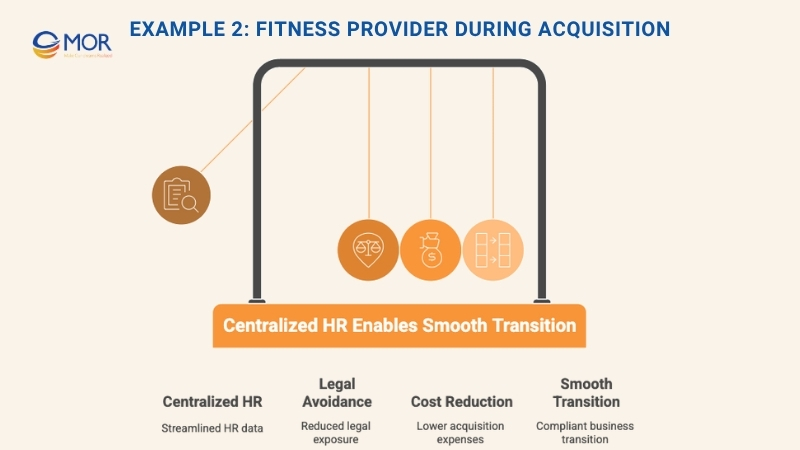
Fitness Provider: Turning Around HR Compliance During an Acquisition
Get Professional HR Risk Management With MOR Software
HR risk management works best when your systems do the heavy lifting. At MOR Software, we help companies reduce workforce risk with scalable, secure, and fully customized HR tech. Whether you're managing compliance, preventing data leaks, or tracking team performance, we design tools that give your HR team more clarity and control without extra manual effort.
Here’s what we bring to the table:
- Custom HR platforms that automate core processes like onboarding, time tracking, and policy management
- Built-in analytics to detect early signs of turnover, skill gaps, or declining engagement
- Security-first design, with encrypted employee data, access controls, and regular system testing
- Mobile and cloud-based apps to support hybrid teams and maintain consistency across locations
- Integrated compliance features that keep you aligned with changing labor laws and internal standards
With the right platform in place, HR risk management becomes proactive, not reactive. We help you build systems that spot issues early, streamline decision-making, and protect your people and your brand. Contact us to get started.
Conclusion
HR risk management isn’t just about avoiding problems, it’s about building a workplace that runs smoother, stays compliant, and supports long-term growth. From hiring to data security to AI tools, today’s HR teams face more risk than ever. But with a clear plan, the right tools, and ongoing review, these risks become manageable.
Whether you're tackling legal compliance, improving retention, or adapting to new tech, strong HR risk management solutions help you stay ahead. And when your team is equipped to act early, your entire organization benefits. At MOR Software, we build tailored systems that support smart, scalable HR and risk management. From automation to analytics, our solutions help HR teams work smarter, not harder. Contact us to start building your custom risk management platform today.
Rate this article
0
over 5.0 based on 0 reviews
Your rating on this news:
Name
*Email
*Write your comment
*Send your comment
1